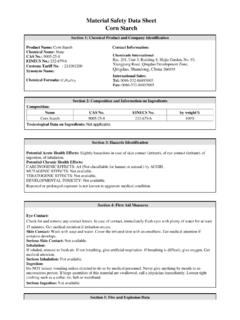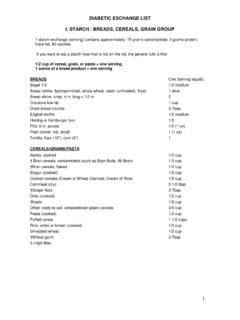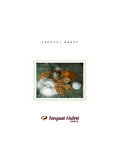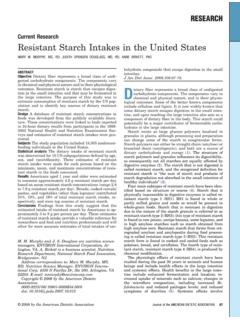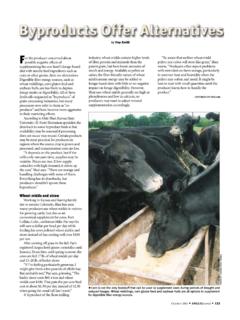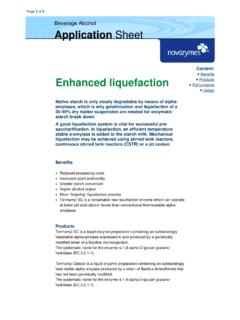Transcription of Chapter 18 Starch-based plastics - Biodeg
1 Book 3 - Technology, use and potentialities of Latin American starchy tubers Chapter 18. Starch-based plastics Olivier Vilpoux1 & Luc Introduction Brazil disposes of approximately 240,000 tons of waste per day, an amount lower than that in the USA (607,000 ), but fairly above those in countries such as Germany (85,000 ) and Sweden (10,400 ). Of that total, a large amount goes to open waste deposits. Only a small quantity is disposed of in appropriate places. A city like S o Paulo spends, per day, US$ 300,000 with waste. According to the Instituto de Pesquisas Tecnol gicas IPT (Institute of Technological Research), only few munici- palities have specific teams and public policies engaged in dealing with the waste.
2 When it is not treated, waste becomes a serious sanitary problem, since it exposes the community to illnesses like diarrhea, amebiasis, and parasitosis, apart from contami- nating the soil, waters and water tables. Among solutions, there are the creation of sanitary landfills in appropriate places, adoption of selective collecting and recycling programs, conducting of campaigns with the aim of both making society conscious about the problem and demanding a greater participation of government authorities (Editora Abril, 2002).
3 The manufacturing of biodegradable material offers an interesting solution for plastic materials. Like it hap- pens with organic residues, such as foodstuff, elimination of biodegradable materials is not automatic and is considered as a recycling process by many experts. Biodegrad- able materials go through a composting process, for the obtaining of a stable com- pound, considered the final product of recycling. The bioplastics found in the market are made mainly from starch . Starch-based bioplastics represent from 85% to 90% of market's bioplastics (Bastioli, 2000).
4 Among starch bioplastics are those manufactured with native or slightly modified starches, either isolated or blended with natural or synthetic molecules. In addition, there is also the result from the lactic acid polymerization obtained through the fermentation of starch . Within this later category is the PLA (polylactic acid), considered the one with the largest potential for the next years. 1. - NGO RA ZES - Av. Manaca, 524 18607-170 Botucatu SP - Brazil. 2. - Strasbourg University Professor - ECPM - France 521. LATIN AMERICAN STARCHY TUBERS.
5 Biodegradable materials Guilbert (2000) defines three types of biodegradable materials: Agricultural polymers used alone or blended with biodegradable synthetic poly- mers;. Microbial polymers, produced from the fermentation of agricultural products used as substract. Averous (2002) identifies within this class the Polyhydroxy Alkanoates, or PHA. Its most widely known representative is the PHBV (Polyhydroxybutyrate covalerate). Monomers or oligomers polymerized by means of conventional chemical processes and obtained from the fermentation of agricultural raw materials used as substract.
6 The most well known material within this category is the PLA. Averous (2002) includes a fourth class to the above-mentioned ones: Derivatives by means of synthesis, obtained from the petrochemical industry by the classic synthetic via. The latter one is represented by several polymers and subgroups: The polycaprolactones: PCL;. The polyesteramide: PEA;. The aliphatic copolyester or Polybutylene Succinate Adipate: PBSA. The aromatic copolyester, such as the Polybutylene adipate co-terephthalate: PBAT. PCL and PLA are the polymers most used in the market, except for starch derivatives (Averous, 2002).
7 Figure shows the different families of biopolymers, and their raw materials. 522. Book 3 - Technology, use and potentialities of Latin American starchy tubers Source: Adapted from Averous (2002) and Weber (2000). Figure Different families of biodegradable polymers and their raw materials. Figure indicates the chemical formulas of main biodegradable polymers. Figure Chemical structure of several biodegradable polyesters. 523. LATIN AMERICAN STARCHY TUBERS. According to Weber (2000), Starch-based packagings will continue developing with the support of their niches of traditional non-food markets.
8 Later, starch biopolymers should enter the food market, after that resistance to humidity and cost-related prob- lems are solved Starch-based plastics The use of starch in the manufacturing of bioplastics began in the 70's (Curvelo et al., 2001). Among its advantages, the starch is cheap, abundant and renewable. Besides, it is found in several forms due to the origin of its raw material (Lawter and Fischer, 2000). In the granular state, it has been used as filling agent for polyolefin and as a component in synthetic polymers blends.
9 According to Lawter and Fischer (2000), starches have also been modified by means of grafting with vinyl monomers ( , methyl acr- ylate), originating materials for injection in molds or extrusion. It is possible to produce starch films through the grafting of polymers, such as Polyethylene (PE). Only the starch is biodegradable and these films are practically no longer used (Lawter and Fischer, 2000). According to Kaplan (1998), a silane with a general formula of CH3-Si-O-(R1,R2,R3) can be added to a blend of PE to improve the compatibility of these two materials.
10 Thermoplastic-like starch (TPS). The TPS is a relatively new concept and, today, it is one of the main research hints for the manufacturing of biodegradable materials (Curvelo et al., 2001). The starch is not a real thermoplastic, but, in the presence of a plasticizer (water, glycerin, sorbitol, etc.), high temperatures (90 180 C) and shearing, it melts and fluidizes, enabling its use in injection, extrusion and blowing equipment, such as those for synthetic plastics . So as to obtain a thermoplastic starch , it is necessary that the starch maintains its semi-crystal granular structure and that it behaves in a way similar to that of a melted thermoplastic, obtained through a mono- or twin-screw extrusion with the use of me- chanical and thermal energy (Lourdin et al.)

